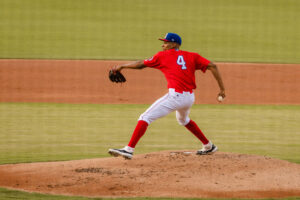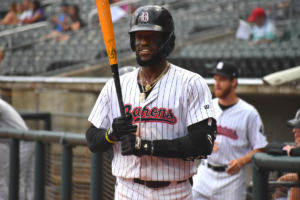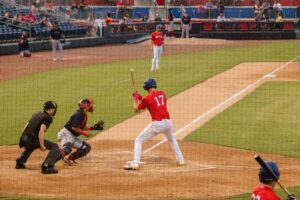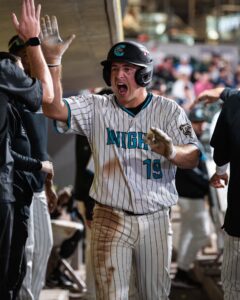FutureSox 2020 Midseason Rankings roundtable: Writers’ high and lows
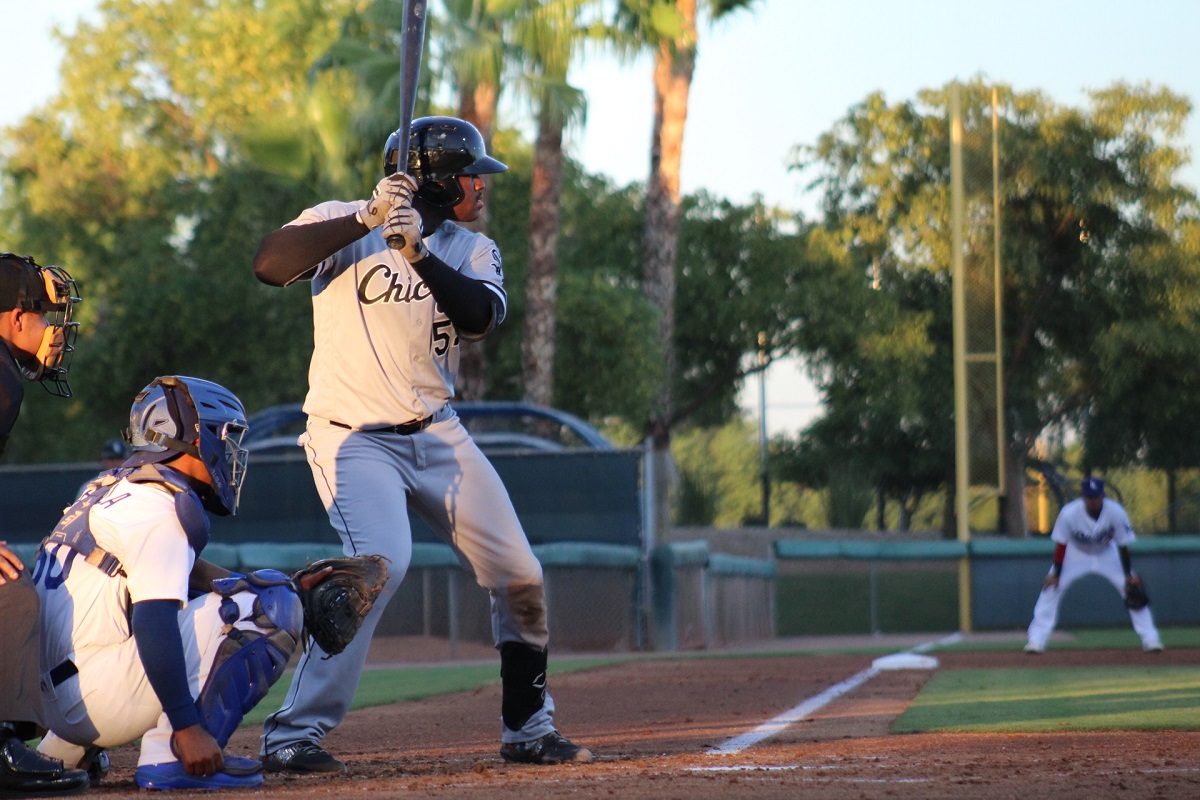
Twice annually, our writers huddle and compile their personal top 30 rankings of White Sox prospects. That’s before the real fun begins. Questioning, critiquing and sometimes arguing comes next as we try to determine the best possible list. This roundtable allows the writers a chance to explain why they were the outliers on certain prospects.
The end result is our final FutureSox Top 30 list, which is a weighted fusion of our original lists. This article is an on-going series that allows our writers to explain their rationale for a prospect they ranked higher or lower than the general consensus. The first number next to each prospect is the ranking assigned by that writer and the second number is what they were ranked on the actual list.
James Fox
Highest: Jake Burger (14th, 18th)
Burger saw the biggest jump on our top 30 list from the preseason version to the midseason update and it’s mostly due to health and new information. The 24-year-old infielder was drafted 11th overall in the first round by the White Sox back in 2017. The Missouri State product was drafted for his bat, but the defense was sneakily solid as well for a guy of Jake’s size. Burger has been out of action the last two years after rehabbing multiple Achilles’ tears. Many wrote him off but some of the reasons the White Sox invested in Burger in the first place were due to his character and work ethic.
Burger is now healthy and participating at the alternate site in Schaumburg. The third baseman played in the CarShield Collegiate League to get his feet under him and play in games prior to returning to action with the White Sox. He has lost roughly 25 pounds and looks as good as he has since being drafted. The organization is excited by his exit velocity readings and the batted ball data consumed from his hitting sessions. Burger is playing third base in Schaumburg, but he’s mentioned that playing other positions is something on the horizon. It’s an important offseason for Burger with his Rule 5 Draft candidacy coming this December. Due to his prospect pedigree and proximity to the majors if healthy, Burger is absolutely a top 15 prospect in this system.
Lowest: Gavin Sheets (18th, 14th)
Sheets was given a $2 million bonus in the second round of the 2017 draft out of Wake Forest. The slugger was drafted due to his advanced data with a power/patience profile. Sheets didn’t get to his power enough in games in A ball, but he always walked at a solid rate and put the bat on the ball. His batting practice power shows were lauded by scouts and observers throughout. Sheets went to Double-A Birmingham in 2019 and struggled initially, but bounced back nicely. The left-handed masher hit .267/.345/.414 with a 10% walk rate for the Barons. Sheets also hit 16 homers playing his home games in a cavernous ballpark while leading the Southern League in RBI.
The 2020 season in Charlotte was going to be an important one for Sheets. Playing home games in a friendly hitter’s haven would have likely done wonders for Sheets. The player is keenly aware that power has to be part of his game and he’s tried to make that a focus of his training. In an interview with FutureSox recently, Sheets clarified that he’s been working in the outfield and has been getting his body in shape to make the transition a realistic possibility. Sheets is Rule 5 eligible this December and the organization has an interesting decision to make. I’ve been the lowest on Sheets as a prospect due to his positional value. If Gavin stays at first base, he has to put up huge power numbers to be effective. He could be an important member of the franchise going forward, but he’s the biggest name prospect not to be included at the alternate site in Schaumburg. That could be telling in regards to the organization’s thoughts on the player.
Mike Rankin
Highest: Gavin Sheets (12th, 14th)
Sheets boasts over 1,250 plate appearances in 301 minor league games. His 83 RBI led the Southern League and he also ranked in the top 10 in home runs with 16. His first stint in Double-A resulted in an encouraging 10 percent walk rate and 122 wRC+.
It appeared Sheets consciously tried to hit for more power in 2019. His average dipped and his strikeout rate increased. Sheets is a player who takes pride in maintaining a disciplined plate approach while limiting the strikeouts and producing hard contact to all fields – especially to his pull side. I’m not worried about the power as long as his hard-hit rate remains intact. If he finds a way to establish consistency at the plate, then the White Sox will figure out how to work him in at the big league level.
All indications suggested Sheets was ticketed for Charlotte at the start of MiLB’s 2020 season. Unfortunately, the work stoppage impacts Sheets rather significantly, as he turns 25 in April.
Lowest: Benyamin Bailey (29th, 22nd)
I listed Bailey in slot No. 29 in my 2020 individual preseason top 30 list as well. In his first season as part of the White Sox, Bailey slashed .324/.477/.454 across 55 games in the Dominican Summer League as a 17-year-old in 2019. Turning 19 in September, the Panamanian outfielder had his momentum abruptly halted due to the pandemic, as we await his progression toward playing stateside.
I’m excited to see Bailey compete in his second professional season, as his listed 6-foot-4, 215 pound frame continues to develop as he ages. The tools are there, although very raw. Bailey’s lanky frame at the moment has me thinking about his bat speed, arm strength in the outfield and his ability to move athletically around the base paths and as a defender. Allow me to see this kid play more, please.
Jasper Roos
Highest: Jonathan Stiever (6th, 8th)
As I wrote in my individual top 30, I just love the talent, the progression and the development of Stiever over the past year and a half. He looks like a pitcher. Many of my fellow writers ranked at least Kelley ahead of Stiever, but I tend to be a little more conservative with high school arms. Stiever has done nothing to diminish my belief in him (granted, he has literally done nothing, as we haven’t seen him pitch since spring training). He’s consistent, he’s got the K-rate and walk-rate to back it up, and I believe he develops the way you’d want a pitcher to develop. I can’t say for sure if he’ll be able to keep Kelley behind him for long, because the latter has a chance to be a once-in-a-lifetime arm, but I want to see him pitch in competitive professional games first before making sweeping statements. For now, Stiever is my guy.
Lowest: Micker Adolfo (13th / 11th)
I’ll take over for Dan here as the low-guy on Adolfo, compared to our preseason rankings. As Dan said back then, Adolfo comes with some serious bust risk, despite the clear physical tools. I swapped him, Gonzalez and Rutherford around mostly based on ‘what have you done for me lately?’ Gonzalez has seen big league time in 2020, while Rutherford passed the eye test in spring training. Adolfo… did not.
Sure, on paper Rutherford didn’t fare much better than Adolfo this spring in the same amount of at-bats. In fact, Rutherford’s OPS of .385 was actually lower than Adolfo’s .404, but Rutherford just looked much better. The lefty hit several balls on the screws; he just hit them right at people. He also struck out only three times. Adolfo hit exactly one ball semi-hard for a double, while striking out 11 times in 13 at-bats!! He looked completely overmatched. Those couple of weeks put me in the ‘officially worried’ category. Given his injury history and difficult 2018, I didn’t drop him too far down just yet, but the Sox’ decision to let Basabe go fairly easily could spell problems for Adolfo in the future too. Like Basabe, Adolfo is Rule 5 eligible this offseason, and it may be hard to justify keeping him on the 40-man if the need arises to protect someone else, given his disappointing last couple of years.
The same can be said for Rutherford, by the way, but that’s a different story.
Dan Santaromita
Highest: Codi Heuer (11th, 16th)
Heuer’s stuff plays in the majors and plays well. The only piece missing for him is experience. He was the second player to reach the majors from the 2018 draft and has hit the ground running. His high 90s fastball and slider combo, with good command, gives him the profile of a high-leverage reliever. For a reliever to be this high in prospect rankings, you better be that good. I think Heuer will get there. It also speaks to how I view the crop of position players just below him. There’s a lot of question marks in that group. Heuer is more of a sure thing at this point.
Lowest: Blake Rutherford (16th, 13th)
The story hasn’t changed for Rutherford since he was drafted. He needs to develop more power. Unfortunately, we haven’t had the chance to see if it was going to come this year. Can he develop into a starting corner outfielder or will he be another version of Ryan Sweeney? Right field remains a question mark for the White Sox long-term and if there was a minor league season, Rutherford could have made his case to be a potential answer. As it stands, he isn’t a prospect to pencil into future plans.
Sean Williams
Highest: James Beard (21st, 24th)
Beard got his first taste of professional baseball in 2019 with the AZL White Sox and it was a struggling season for the speedy outfielder. Beard slashed .213/.270/.307 with 54 strikeouts in 31 games and posted a wRC+ of 61 in rookie ball. The initial struggles were to be expected with Beard, who scouts say wasn’t always facing up against tough competition during his prep career in Mississippi.
Despite the struggles, there’s a lot to like about Beard’s game and the tools he brings to the organization. For starters, the speed is very legit and he utilizes that on the basepaths and in the field as well. While he did struggle with timing at the plate, he did show the ability to hit the ball hard with some occasional pop in his bat. It’s going to take some time for Beard to figure things out and he could be considered as a “project” prospect. However, if or when he does put it all together, he has the potential to be a true two-way player in the White Sox organization. I think that sets him apart from the other young outfield prospects in the lower levels of the minors.
Lowest: Jose Rodriguez (29th, 29th)
Editor’s note: Yes, Sean has Rodriguez at the same spot he finished in the overall rankings, but by a weird fluke of our voting everyone else had him higher.
Rodriguez was a pleasant surprise in 2019, showing a solid amount of power for his smaller 5-foot-11, 175-pound frame. Rodriguez finished 2019 slashing .293/.328/.505 with nine home runs, seven doubles/ and three triples in 44 games. His performance was good for a wRC+ of 121. Don’t get me wrong, I think Rodriguez has been an exciting development in the lower levels of the minors. However, I would like to see him face off against tougher competition before I can feel comfortable with moving him up higher on the list.
He didn’t seem very overwhelmed in the AZL and was a presence in the White Sox lineup each day. However, there were also guys like Bryan Ramos who are younger than Rodriguez and putting up respectable numbers in the same league, which gave Ramos a slight edge over Rodriguez in my opinion. Rodriguez hasn’t done anything to hurt his stock. I personally would like to see him get a shot against a higher level of competition before moving him back up on the list.
Steve Hasman
Highest: Blake Rutherford (12th, 13th)
As the high man on Rutherford, what I found most interesting is how he rebounded after a rough first two months in his Birmingham debut. Of the outfielders not named Luis Robert, Rutherford saw the biggest improvement after making adjustments and settling in at AA. Rutherford was also the youngest outfielder on the Barons (besides that Luis Robert fellow), so it was very encouraging to me to see his progression after dealing with some “personal stuff” per Chris Getz in April and May.
Rutherford bulked up in the offseason and has put more emphasis into driving the ball with more elevation and utilizing an all fields approach. The added strength was noticeable in spring training and has been on display at the alternate site camp in Schaumburg. Rutherford has also been training with someone named Christian Yelich in the offseason. Obviously, that doesn’t mean he’ll turn into the next Yelich, but training with a star has its benefits. Rutherford isn’t the same level of defender as Luis Gonzalez, but I believe that the added strength will start translating to in-game power. That complimented with his age and prospect pedigree sets him apart from Gonzalez for me.
Lowest: Matt Foster (29th, 26th)
I’ll start off by saying that Foster has been a key cog in the White Sox bullpen this season, vital to the team’s overall success. I’ve thoroughly enjoyed watching him pitch. I ranked him 29th because I generally put more value into positional prospects over relievers. In addition, ceiling is important here. Foster was projected to fit into more of a seventh inning role, which is valuable, but not as valuable as a eighth or ninth inning type reliever.
Foster has put up solid numbers across his minor league career, but doesn’t necessarily possess a true “above average” pitch. His main pitches, the fastball and changeup, have spin rates within the MLB average, where the slider lags behind a bit. The horizontal movement and drop on his pitches mostly trails behind league average as well. Obviously, those metrics aren’t the end all be all for Foster’s career trajectory, they were just metrics I found interesting when digging deeper. Foster could very well prove his projections wrong and exceed expectations, which is something I would absolutely be in favor of.
Adam Hess
Highest: Jimmy Lambert (12th, 15th)
I must admit I was a bit surprised to find myself as the high man on Lambert. In a system that is packed with arms in the 5-15 range of the rankings, Lambert still stands out to me in some ways because he has a strong fastball-breaking ball combination. His fastball has one of the best spin rates in the minors, giving it great carry that helps avoid bats despite not having overpowering velocity like others in the system. Pairing that with a plus 12-6 curveball and two average offerings in his change and slider gives him a nice, well-rounded repertoire. I find it really unfortunate that he lost his 2019 and 2020 seasons to injuries. That threatens to derail a career that seemed like it may have been getting off to a strong start. Moving forward, I think Lambert can carve out a role as a long-term swingman bullpen piece or even a back-end starter for the White Sox.
Lowest: Yolbert Sanchez (20th, 17th)
To be blunt, I am not extremely high on Sanchez. Quite frankly, I thought I had rated him a little lower than 20th. My key concern with Yolbert is that I don’t see much of a future with the bat, meaning his glove is going to need to carry him to any future role in the big leagues. While that tool may be good enough to do so, I am not sure it will ultimately be good enough to displace a player like Danny Mendick, who may be lower on my prospect rankings but has the advantage of already being at the big league level. Sanchez strikes me as a clone of, ironically, Yolmer Sanchez. Being an older prospect who has yet to play baseball stateside and is reliant on his glove to make it to the bigs plays against him in my mind. I do think his floor is that of an MLB bench player, but I will need to see more from Yolbert, and soon, before I consider moving him up my list.
Want to know right away when we publish a new article? Type your email address in the box on the right-side bar (or at the bottom on a mobile device) and click “create subscription.” Our list is completely spam free, and you can opt out at any time. Also, consider supporting FutureSox on Patreon! You can get early access to special articles and Patreon-only posts, in addition to more benefits.
Shop our exclusive merchandise! Show your support with FutureSox apparel.

